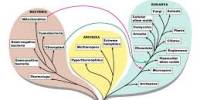Paleobiology is a branch of biology that studies the evolution of life on Earth, particularly through the study of fossilized remains. It is an interdisciplinary field that combines the methods and findings of earth and life sciences. To understand the evolution and diversity of life over geological time, this field integrates principles and techniques from a variety of scientific disciplines, including paleontology, geology, biology, chemistry, and physics.
Paleobiology should not be confused with geobiology, which is concerned with the interactions of the biosphere and the physical Earth. Paleobiological research examines current biota and fossils millions of years old to answer questions about the molecular evolution and evolutionary history of life. Typically, macrofossils, microfossils, and trace fossils are studied in this scientific quest. However, 21st-century biochemical analysis of DNA and RNA samples, as well as biometric construction of phylogenetic trees, hold great promise. A paleobiologist is an investigator in this field.
Key aspects of paleobiology include:
- Fossil Record: Paleobiologists analyze the fossil record to reconstruct the history of life on Earth. Fossils are the preserved remains or traces of organisms from past geological ages. By studying fossils, researchers can learn about the morphology, behavior, and ecological interactions of ancient organisms.
- Evolutionary Processes: Paleobiologists contribute significantly to our understanding of evolutionary processes. The fossil record provides crucial evidence for the study of speciation, extinction events, adaptive radiations, and other evolutionary phenomena.
- Paleoecology: This subfield focuses on understanding ancient ecosystems, including the relationships between different species and the environmental conditions that influenced their distribution and abundance.
- Stratigraphy: Paleobiologists collaborate with geologists to interpret the stratigraphic layers where fossils are discovered. The study of stratigraphy aids in the chronological order of fossils and provides insights into the Earth’s geological history.
- Biostratigraphy: This entails dating and correlating rock layers using fossils. Different species have distinct fossil record ranges, allowing researchers to construct a timeline of Earth’s history based on the presence or absence of specific fossils.
Overall, paleobiology is important in unraveling the mysteries of life’s history and provides valuable information to fields such as evolutionary biology, ecology, and Earth sciences. Researchers in this field frequently work across disciplines to gain a comprehensive understanding of the complex interplay between life and the changing environment of the Earth over millions of years.
















